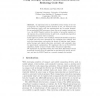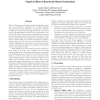111 search results - page 1 / 23 » Using Multiple Memory Access Instructions for Reducing Code ... |
CC
2004
Springer
13 years 9 months ago
2004
Springer
An important issue in embedded systems design is the size of programs. As computing devices decrease in size, yet with more and more functions, better code size optimizations are i...
CC
2003
Springer
13 years 9 months ago
2003
Springer
Abstract. In DSP processors, minimizing the amount of address calculations is critical for reducing code size and improving performance since studies of programs have shown that in...
ACMMSP
2004
ACM
13 years 9 months ago
2004
ACM
Instruction combining is an optimization to replace a sequence of instructions with a more efficient instruction yielding the same result in a fewer machine cycles. When we use it...
CASES
2003
ACM
13 years 9 months ago
2003
ACM
In an embedded system, the cost of storing a program onchip can be as high as the cost of a microprocessor. Compressing an application’s code to reduce the amount of memory requ...
HPCA
2005
IEEE
14 years 4 months ago
2005
IEEE
The use of large instruction windows coupled with aggressive out-oforder and prefetching capabilities has provided significant improvements in processor performance. In this paper...


